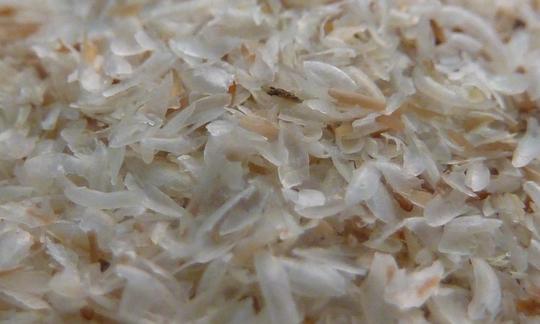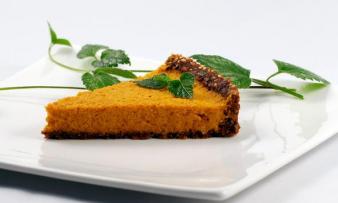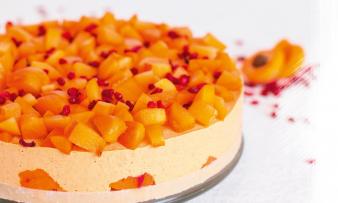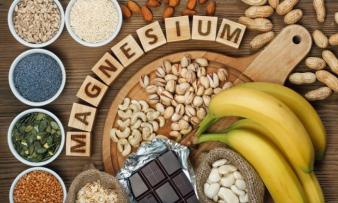Table of contents
In the trade, the term psyllium husk basically refers to the seed pods of the Indian psyllium ( Plantago ovata ). As well as their husks, the psyllium seeds of Plantago indica and Plantago afra are also recognized as a remedy for constipation and diarrhea. In the kitchen, the seed pods are used as a binding and thickening agent.
Using psyllium husks in the kitchen:
Are psyllium husks suitable as a binding agent? Thanks to their good swelling properties and binding effect, psyllium husks are an excellent ingredient in the kitchen. If you mix them with water, they swell up into a jelly-like mass without boiling. This makes psyllium husks particularly useful for raw food cooking and a great raw vegan alternative to agar-agar , which has to be cooked. Both the husks and whole psyllium seeds swell up and can be eaten raw.
You can make a raw jam from psyllium husks with berries (e.g. strawberries ) or other fruits (e.g. apricots or mangos ), a little agave syrup and lemon juice , pureed in a blender. No sweetener is needed for dried fruits. However, the shelf life is limited to about a week. The binding effect of psyllium husks can also be useful for making puddings. Linseed and chia seeds are often used as swelling fiber for puddings. Chia seeds and linseed that are not ground and are only pickled have a spherical consistency and their own taste. Psyllium husks, on the other hand, are tasteless and can swell up to 40 times their volume.
Raw, vegan mozzarella can also be easily prepared with macadamia nuts , psyllium husks, water, lemon juice and yeast flakes . Soak the macadamia nuts, allow the psyllium husks to swell and then puree both with the remaining ingredients. Put into a mold or form the mixture into a ball and then chill in the refrigerator.
Psyllium husks are also a good vegan binding agent for baked goods. If you avoid flours or eggs that contain gluten, you can improve the binding ability and elasticity of the dough by adding psyllium husks. If you let psyllium husks swell in a plant-based drink (e.g. oat milk ), the thickening creates a solid mass that can be used as a filling for cakes.
When thickening soups and sauces, you should be careful with the amount of liquid so that they do not become too viscous.
Dishes containing psyllium husks keep you full for longer. Due to their swelling properties, psyllium husks increase the volume of food and thus promote the feeling of satiety. Soups, sauces, shakes and smoothies enriched with psyllium husks are therefore more filling, rich in fibre and aid digestion - with practically no additional calories.
Vegan recipe for raw food pudding with psyllium husks:
Ingredients (for 2 people): 4 tsp psyllium husks (organic), 2 bananas , 2 tbsp unsweetened cocoa , 200 ml plant milk (e.g. rice milk , oat milk ), optional:vanilla powder or cinnamon . Depending on your preference, you can sweeten the pudding with agave syrup .
Preparation: Put the plant milk with the psyllium husks in a container and leave to rest for 30 minutes. Then add the bananas and optionally the agave syrup, vanilla or cinnamon and puree the mixture with a hand blender. Mix half of the mixture with the cocoa powder. Serve both types of pudding together and garnish with toppings (e.g. strawberries or other fruit).
Vegan recipes with psyllium husks can be found under the note: " Recipes that have the most of this ingredient ".
| Not only vegans or vegetarians should read this: Vegans often eat unhealthily. Avoidable nutritional mistakes . |
Shopping - where to buy psyllium husks?
Psyllium husks are available in many supermarkets in the standard range (e.g. Coop , Migros , Spar , Rewe , Edeka ) and occasionally in other supermarkets (e.g. Billa , Denner , Volg , Lidl , Aldi , Hofer ). Organic psyllium husks can definitely be found in organic supermarkets (e.g. Denn's Biomarkt , Alnatura ), health food stores or drugstores. Whole psyllium seeds (raw) are more commonly available. Harvest time is June to October for Mediterranean psyllium seeds and March for Indian psyllium seeds. 13 Husks and seeds are available in stores all year round.
The availability of psyllium husks in the supermarkets mentioned varies depending on the size of the store, catchment area, etc. If you are interested, click on our recorded food prices for the DA-CH countries (above under the ingredient image). There you will find current prices from various supermarkets and their price development.
Found in the wild:
Plantago ovata ( Indian psyllium ) includes annual herbaceous plants with pointed, woolly-hairy leaves and boat-shaped, light pink to beige 4, 13 (or yellowish or brownish) seeds. They are divided into four subspecies (varieties) that originate from different areas: Plantago ovata var. ovata comes from North Africa, Po decumbens from the Middle East, Po fastigiata can be found in desert areas of North America and Po insularis on the Pacific coast of North America and on the Channel Islands. 14, 18
Other types:
The psyllium herb of the European species Plantago afra L. and Plantago indica L. grows as an annual with branched stems, narrow, oppositely arranged, lanceolate leaves and short spike-like inflorescences. The seeds of these European species look very similar, they are dark brown to shiny red-black, 2-3 mm long and elliptical in shape. The shrub plantain or psyllium plantain ( Plantago afra L. , syn. Plantago psyllium L.) comes from the western Mediterranean region 2,4 and grows wild in fields, on roadsides, open shrub heaths and in ruderal areas. It is now also found in Eastern Europe as far as West Asia and from North to East Africa. 19 The sand plantain ( Plantago indica L., Syn. Plantago arenaria Waldst. & Kit.) grows in southern and eastern Europe and southwest Asia. 2.4
The seeds of the European native ribwort plantain ( Plantago lanceolata L.) contain only small amounts of mucilage, which is why they are not used therapeutically. 4 The plant can be found growing wild in dry meadows, fields, rubble heaps and on roadsides, similar to the broadleaf plantain ( Plantago major ).
Storage of psyllium husks:
Psyllium husks are best stored in an airtight jar in a dry place protected from light; they will then last up to 2 years.
Ingredients - nutritional values - calories:
The nutritional values of psyllium husks (raw) are as follows: The energy content is 41 kcal/100g. With 1.2 g protein and 0.3 g fat per 100 g, psyllium husks are very low in protein and almost fat-free. The carbohydrate content is 89 g/100g, of which only 0.2 g is sugar. 1
On the other hand , the fiber content is very high at 81 g/100g. Healthy recipes with psyllium husks such as pea pudding therefore cover a high proportion of the daily fiber requirement. Please note the recommended consumption amounts (see "Health aspects - effects").
Psyllium husks have a high mineral content, but vitamins are underrepresented. 100 g of raw psyllium husks contain 2.6 mg of manganese . Chia seeds (2.7 mg/100g) and linseed (2.5 mg/100g) have a similar amount of manganese. 1
The magnesium content of psyllium is 374 mg/100g. Fennel seeds (385 mg/100g) and cumin seeds (366 mg/100g) have a comparable magnesium content. 1
The phosphorus content is 618 mg/100g and is comparable to that of raw sesame (629 mg/100g) and cashew nuts (593 mg/100g). 1
Do psyllium husks contain potassium? 100 g of psyllium husks contain 847 mg of potassium . Raw wheat germ contains similar potassium levels (892 mg/100g). 1
The complete ingredients and nutritional values of psyllium husks, the coverage of the daily requirement and comparison values with other ingredients can be found in our nutrient tables. In the article Nutrients explained you will get a detailed insight into the topic.
Dangers - intolerances - side effects:
When taking psyllium, make sure you drink plenty of fluids , otherwise constipation may occur. If you suspect intestinal obstruction (ileus), narrowing of the digestive tract (stenosis), diseases of the esophagus or difficulty swallowing, do not consume psyllium. 2,3 In addition, you should not take psyllium husks immediately before going to bed. 3
Taking Indian psyllium at the same time as vitamins, minerals, blood thinners or cardiac glycosides can delay absorption. Because of the possible delayed absorption of medication, guidelines recommend a waiting period of at least one hour. 21 A possible weakening effect on thyroid hormones cannot be definitively ruled out. In addition, if taken incorrectly and combined with other swelling laxatives (and substances that inhibit bowel movement), intestinal obstruction can occur. 20
Although the reduction in blood sugar levels is fundamentally viewed as positive, it may require diabetics to adjust the medication they take. 20
The German Federal Office of Consumer Protection and Food Safety issued a salmonella warning for psyllium husk powder and capsules in 2021. 16 Denmark also drew attention to salmonella contamination. 17
Health aspects - effects:
Psyllium and psyllium husks help against both constipation and diarrhea, although psyllium husks are more effective. 4 Since the mucus-forming properties are found in the husk, they have a significantly higher swelling index compared to the whole seeds. When mixed with water, psyllium husks swell up to 40 times their dry weight. 4 Due to their absorption capacity, psyllium husks have a binding effect on diarrhea. The gel-like, fiber-rich psyllium husk mass increases the intestinal contents, which triggers a stretching stimulus that then leads to bowel movements. This is why psyllium husks are also used against constipation. Due to their swelling capacity, they improve stool consistency and stool frequency. 2 Psyllium seeds also support digestion through their prebiotic properties, which promote the growth of intestinal bacteria and thus contribute to a healthy intestinal flora. 6
The swollen psyllium husks fill you up quickly and are rich in fiber, which leads to less hunger between meals. It can therefore be assumed that psyllium husks support weight control and weight loss. 7 In a randomized study, overweight adults who took 12 g of psyllium husks in 250 ml of water three times a day before meals for 12 weeks found that not only their body weight and body fat but also their cholesterol and LDL cholesterol levels were reduced. 8
The US Food and Drug Administration confirms that psyllium husks can reduce the risk of type 2 diabetes. However, there are still too few scientific studies to clearly prove this. 12 A positive effect on fasting blood sugar has been shown in both diabetics 9,10 and people without diabetes 11 when psyllium husks are taken regularly.
Recommended maximum amounts: There is varying information on maximum amounts in the literature. While information on psyllium husk-based medicines recommends a maximum daily dose of around 21 g of psyllium husk for long-term use (corresponds to around 3 heaped teaspoons for these medicines), 21 there are studies in which participants were given 3 x 12 g for 12 weeks (a total of 36 g per day). 22 With regard to the feeling of satiety in healthy subjects, a short-term study showed that 10.2 g per day (divided into 3 doses, each with 295.7 ml of water) resulted in a longer feeling of satiety between meals. 23 If we look at the amount in terms of the effect on glucose metabolism, the strongest effects were seen with daily doses of between 10 and 15 g of psyllium - other doses used by the study leaders had no relevant influence on the result. 4
Based on this information, we recommend a daily intake of 10 to 15 g of raw psyllium husks per day, divided into 3 doses with sufficient fluid intake (up to 300 ml of water per dose).
Use as a recognized medicinal plant:
Psyllium is listed as a drug (Plantaginis ovatae semen 24 and Psyllii semen 3 ) by the HMPC as having well-established medical use for internal use in chronic constipation and to soften stools. It is also recognized as a medicinal plant by ESCOP and Commission E.
Occurrence - origin of Plantago :
Psyllium husks come from different psyllium species. The products that are sold are mainly from Plantago ovata Forssk. (syn. Plantago ispaghula Roxb.), 14 which is also known as Indian psyllium . Gene sequences suggest that the North American varieties are of hybrid origin (varieties from Asia and Africa). 18 Today, Plantago ovata is mainly grown in India, Pakistan and Iran. 2,4 Annual production in India is around 120,000 tonnes, which accounts for around 80% of the entire world market. 5
For use as a drug, psyllium seeds ( Plantago afra and Plantago indica ) mostly come from France and Spain and Indian psyllium seeds mostly from India. 4
Growing in the garden or as a potted plant:
Plantain species for the production of psyllium are rarely grown as plants in one's own garden. In order to produce a certain amount of psyllium, a larger contingent would have to be grown.
Cultivation - Harvest:
The most suitable soil for growing psyllium is sandy loam or pure clay soil. These soils should have good drainage; the optimum pH is between 7.3 and 8.4. Psyllium loves dry, sunny weather during its ripening period. Even light showers or cloudy weather can cause seed shedding and reduce yield. Psyllium is ready for harvest 5 to 6 months after sowing. To avoid seed shedding, cut the psyllium close to the ground. On average, a good harvest yields between 700 and 1000 kg of psyllium per hectare. 15
Danger of confusion:
The leaves of Plantago lanceolata (ribwort plantain) are similar in shape to those of Plantago ovata , except that the latter are hairy. The seeds of the European psyllium ( Plantago afra and Plantago indica ), which are called "black psyllium" (or "French psyllium seed") because of their color, have occasionally been contaminated with seeds of ribwort plantain ("German psyllium seed"). The much lighter "German psyllium seeds" are said to have been roasted for this purpose. 13 But since the swelling capacity of Plantago lanceolata is significantly lower, contamination with ribwort plantain seeds is considered a reduction in quality according to the European Pharmacopoeia .
Industrial production:
The raw material for the production of psyllium husks is the psyllium seeds. First, the psyllium seeds are cleaned of small stones and other impurities using separation machines. The psyllium seeds are then ground in large mills. The mechanical pressure separates the husk from the seeds. The mixture is then sieved and the light psyllium husks are separated from the heavier psyllium seeds using an air blower. The finished product is sometimes treated with ethylene oxide, methyl bromide or gamma radiation to sterilize it. 5
General information:
Psyllium is a type of plantain. The annual herbs are 10 to a maximum of 50 cm high. The white flowers sit on thin stems in cylindrical to spherical spikes. The fruit is a multi-seeded capsule. 2
The small seeds are reminiscent of fleas in their appearance, which is why the plant is called psyllium herb or psyllium plantain.
Alternative names:
The Indian psyllium seeds have the drug name Plantaginis ovatae semen. 24 The psyllium seeds of Plantago afra (syn. Plantago psyllium L.) and Plantago indica are called Psylli semen (formerly Semen psylli). For the seed husks in general, Psyllii testa is often used, the Indian psyllium husks in particular are called Plantaginis ovatae seminis tegumentum. 4
As a non-specific name for the European species and sometimes also for the Indian species, the simple psyllium is in circulation, 12,14 especially in the pharmacological field.
Common names for Indian psyllium or the plant are fleawort, hay seed, Indian plantain (or, unspecifically, sand plantain). Plantago psyllium is known in German as shrub plantain or psyllium herb. Occasionally you also read the singular psyllium husk.
In English, psyllium husks are called psyllium (seed) husk and the seeds are called psyllium. 12 The plant Plantago ovata is also known in the USA as desert Indian wheat, and its seed husks are sometimes called blond psyllium. In Italian, psyllium is called psillio and the husks are called bucce di psillio. In Spanish, psyllium husks are cáscaras de psyllium and psyllium seeds are psilio.
In India, Plantago ovata is known as Isabgol (see botanical syn. Plantago ispaghula Roxb.). The spelling Isabgul is also known, which means "horse's ear". 4,5
Literature - Sources:










Comments